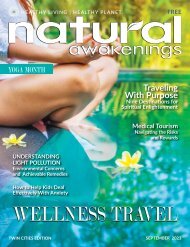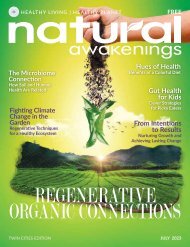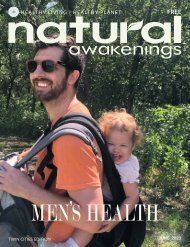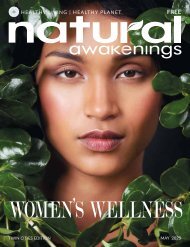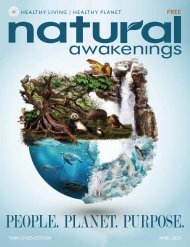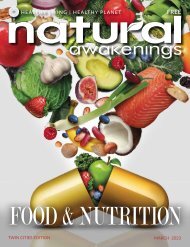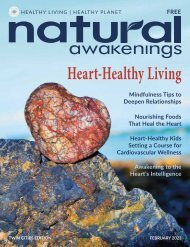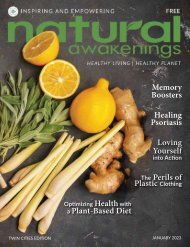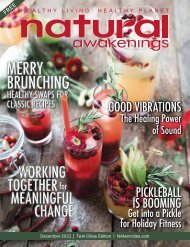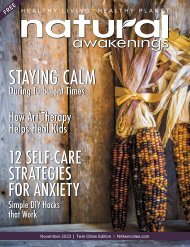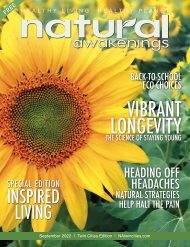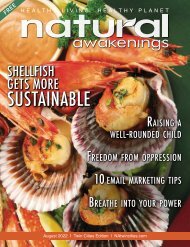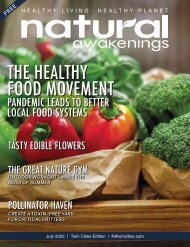Natural Awakenings Twin Cities February 2022
Read the February 2022 edition of Natural Awakenings Twin Cities magazine. This is our annual Heart-Centered Living Issue which is focused on minding the heart and heart and mind connection. This month we feature articles on living on the frequency of love, truly making love, sound of your heart determines your health, fermenting for foodies, parents as role models and so much more! Be sure to check out our local content including News Briefs announcements, Community Resource Guide with providers throughout the metro who can meet your individual wellness needs, and all the happenings in the Calendar of Events. There is additional online-only content that can be found at NATwinCities.com. While you are there, be sure to sign up for our Newsletter and Digital Magazine and continue your reading with our archived articles from local experts.
Read the February 2022 edition of Natural Awakenings Twin Cities magazine. This is our annual Heart-Centered Living Issue which is focused on minding the heart and heart and mind connection. This month we feature articles on living on the frequency of love, truly making love, sound of your heart determines your health, fermenting for foodies, parents as role models and so much more!
Be sure to check out our local content including News Briefs announcements, Community Resource Guide with providers throughout the metro who can meet your individual wellness needs, and all the happenings in the Calendar of Events. There is additional online-only content that can be found at NATwinCities.com.
While you are there, be sure to sign up for our Newsletter and Digital Magazine and continue your reading with our archived articles from local experts.
You also want an ePaper? Increase the reach of your titles
YUMPU automatically turns print PDFs into web optimized ePapers that Google loves.
neurocardiology, which studies their neurological interplay;<br />
and behavioral cardiology, which examines how psychological<br />
and social factors lead to heart disease. Increasingly, researchers<br />
are documenting that the brain and the heart form an intricate<br />
feedback loop that works neurologically, biochemically and<br />
electromagnetically to optimize well-being. What hurts one—be<br />
it artery-clogging foods or angry outbursts—can hurt the other.<br />
What heals one—be it exercising or a good belly laugh—can heal<br />
the other. There’s good news in that, says Miller: “You can heal<br />
your heart by actively engaging in positive emotions each and<br />
every day.”<br />
Unveiling the Heart’s Role<br />
In Western medicine, the heart has been downplayed historically<br />
as a pump mechanistically taking orders from a bossy brain,<br />
but recently, the heart’s role is being reexamined: With 40,000<br />
neurons, it sends more signals to the brain than it receives. As integrative<br />
cardiologist Mimi Guarneri, author of The Heart Speaks,<br />
puts it, “The heart is a multilayered, complex organ, possessing<br />
intelligence, memory and decision-making abilities independent<br />
from the mind.”<br />
The electromagnetic field it generates is about 100 times stronger<br />
than the brain’s magnetic range and can be detected up to<br />
three feet away from the body, report researchers at the pioneering<br />
HeartMath Institute, in Boulder Creek, California. They found<br />
that one person’s brain waves can synchronize to another person’s<br />
heart and two hearts can synchronize to each other, which may<br />
help explain why people are drawn to or repelled by each other.<br />
When the heart’s rhythm pattern becomes erratic and disordered<br />
during stress and negative emotions, they report, the neural signals<br />
traveling to the brain’s emotional centers also get disrupted,<br />
hindering clear thinking and reasoning—which may help explain<br />
why we make dubious decisions under stress.<br />
The High Toll of Tough Emotions<br />
Although scientists debate whether emotions start in the brain,<br />
heart or from physical sensations elsewhere in the body, it’s clear<br />
through magnetic imaging technology that it’s the brain’s task to<br />
process and regulate emotions via the flow of neurotransmitters<br />
through the amygdala, hypothalamus, hippocampus, prefrontal<br />
cortex and other brain regions. Emotions like anger, fear, grief and<br />
anxiety set off a cascade of reactions involving the hormone cortisol<br />
and proteins called cytokines, creating an inflammatory response<br />
that, if it becomes chronic, can promote the accumulation<br />
of plaque in the arteries that can become unstable and rupture,<br />
triggering blood clots that lead to strokes and heart attacks.<br />
Surveying 25,000 participants in 52 countries, the landmark<br />
INTERHEART Study in 2004 concluded that about 30 percent<br />
of heart attacks and strokes are due to psychological factors, and<br />
ongoing research supports this finding.<br />
DEPRESSION. Adults that are depressed are twice as likely to<br />
develop heart disease. In one study, moderate to severe depression<br />
quadrupled the death rate in heart failure patients.<br />
ANXIETY. Researchers have linked chronic anxiety with a 48<br />
percent increased risk of cardiac-related death over 11 years. It has<br />
also been shown to be a risk factor for angina, heart attacks and<br />
ventricular arrhythmia.<br />
SHOCK. A sudden emotional or physical shock, like a death in<br />
the family or an earthquake, can trigger stress cardiomyopathy,<br />
known as broken heart syndrome, which resembles a heart attack.<br />
ANGER. An episode of intense fury—described as “body tense,<br />
clenching fists or teeth, ready to burst”—increases by 8.5 times the<br />
risk of a heart attack within the next two hours.<br />
LONELINESS. Being socially isolated and lonely is linked to<br />
a higher risk for cardiovascular death than hypertension and<br />
obesity—alarming information since more than 60 percent of<br />
Americans report feeling lonely, left out, poorly understood and<br />
lacking companionship, according to a 2020 survey.<br />
Boosting Both Brain and Heart<br />
“There’s no damage caused by negative emotions that positive<br />
emotions can’t heal,” says Miller. A large body of research has<br />
shown that cardiovascular disease risk can be reduced by up to<br />
half with optimism, a sense of humor, forgiveness, social support,<br />
religious faith, vitality, gratitude, altruistic behavior, emotional<br />
flexibility and coping flexibility. People that are optimistic are<br />
less likely to be rehospitalized or die from heart disease, Finnish<br />
researchers report.<br />
“For optimal health, maximize the health of both brain and<br />
heart. For example, if you eat well and exercise, but are still<br />
stressed out, your heart will suffer. Conversely, if you are not<br />
stressed out, but overeat and do not exercise, your brain will suffer,”<br />
says Miller. Some heart-and-mind-healthy strategies include:<br />
DOING THE BASICS. Exercising a half-hour daily and eating a<br />
largely plant-based, Mediterranean-type diet that’s low in saturated<br />
fats has been found in numerous studies to lower the risk<br />
of both cardiovascular disease and cognitive decline. Working<br />
with health practitioners to get blood pressure, blood sugar and<br />
inflammation levels under control, perhaps using supplements or<br />
medications, is also a key preventive step.<br />
GIVING AND GETTING HUGS. Oxytocin, the “love hormone”<br />
released from the pituitary gland during touching and hugging,<br />
lowers blood pressure and heart rate, and regenerates new<br />
heart tissue in animal studies. Proactively reaching out to family,<br />
friends, neighbors and co-workers can nurture affectionate ties,<br />
but if a human isn’t nearby, even hugging a teddy bear has been<br />
shown to release oxytocin—which may explain why 40 percent<br />
of U.S. adults sleep with stuffed animals. Owning a dog, but not<br />
necessarily a cat, makes us more likely to survive a heart attack,<br />
report researchers.<br />
MINDFULLY LETTING GO. As studies with police officers,<br />
healthcare workers and firefighters have demonstrated, mindfulness<br />
training effectively lowers anxiety and depression, even for<br />
those in life-threatening situations. “To be present, ever acutely<br />
<strong>February</strong> <strong>2022</strong><br />
15



